I have been aware of this novel for a while now and aware of its’ canonical status, often being cited as the text which heralded in the golden age detective fiction era. Writers such as Agatha Christie said that it was ‘one of the three best detective stories ever written,’ whilst Edgar Wallace described it as ‘a masterpiece.’ Dorothy L. Sayers said in turn that it was ‘a tale of unusual brilliance and charm, startlingly original’ and G. K. Chesterton called it ‘the finest detective story of modern times.’ With such recommendations I was looking forward to reading this book, but as you might be guessing, my experience with this book was mixed to say the least, even making me call into question its’ canonical position…. (just a little bit anyways)
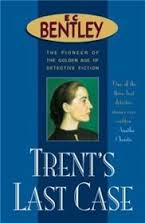
Synopsis
Sigsbee Manderson, a wealthy, but not particularly popular financier is found shot dead. Manderson was not just any financier but THE financier, having a vast amount of influence in Wall Street and his business decisions had the power to affect the lives of many. His death is rumoured to be a suicide, but Manderson’s right hand man, Calvin Bunner contradicts this idea when he informs Sir James Molloy, who is in charge of the Record, that he has been murdered in the grounds of his holiday home, White Gables. Molloy eager for a scoop sends down Philip Trent, an artist, to look into the case, as in the past he has done amateur sleuthing for the paper. He quickly ingratiates himself into Manderson’s household, aided by being an old friend of Manderson’s widow’s uncle, Nathanial Burton Cupples and also being great friends with Inspector Murch of Scotland Yard who is investigating the death.
Information about the case soon comes flooding in, from unusual aspects of the corpse’s dress, Manderson’s unsuccessful marriage and the many curious goings on the night of Manderson’s death, to the fact that Bunner thinks Manderson was being threatened by business enemies. Yet Trent’s investigation gives him little satisfaction, as he comes to a troubling conclusion as to who the killer might be, leaving him unsure which impulse to yield to. Though of course there is the possibility he could be wrong…
Overall Thoughts
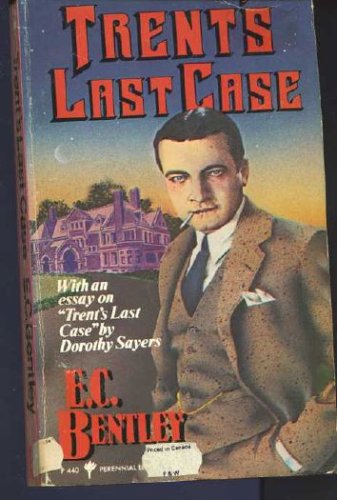
A Send Up Of Detective Fiction?
One of the reasons for its canonical status is that it doesn’t take the detective fiction genre seriously, as asseverated by Christopher Pittard (2010) who views the text as a satire. There is some evidence to support this such as in the title. It is Trent’s first fictional outing yet the title foreshadows that it will be his last. Trent also mocks the genre when he says to Inspector Murch:
‘Let us suspect everybody in the house, to begin with. Listen: I will tell you whom I suspect. I suspect Mrs Manderson, of course. I also suspect both the secretaries – I hear there are two, and I hardly know which of them I regard as more thoroughly open to suspicion. I suspect the butler and the lady’s maid. I suspect the other domestics, and especially do I suspect the boot-boy. By the way, what domestics are there? I have more than enough suspicion to go round, whatever the size of the establishment…’
And it is hard to see the lady’s Maid, Celestine, as anything other than a comedy piece. Yet this could just be me but I didn’t find it that comic, funny or overtly satirical on the whole (excluding the few examples I have given). Is this just me? Did I read it wrong? Writers such as Alan Melville send up the genre much more successfully in my opinion.
The Victim
I think Bentley gives a lot of attention to describing his victim in the opening of the book, whilst also giving a Dickensian touch to this. This can firstly be seen in the opprobrium expressed against hoarding money (A Christmas Carol kind of feel) and also in the way the opening chapter charts Manderson’s career. Bentley also romances the job role of a financier, using phrases such as ‘financial giants,’ ‘piratical romance,’ ‘raiding chieftains,’ ‘financial buccaneer’ and ‘it was, said one of them, as if Blackbeard had settled down as a decent merchant in Bristol on the spoils of the Main. Now and then the pirate would glare suddenly out, the knife in his teeth and the sulphur matches sputtering in his hat band.’ If nothing else these phrases also show the richness of Bentley’s language, which I liked early on but found it wearisome as the book progressed. Golden age detective fiction would go on to have many a dead financier as its victim but I don’t think many were described or focused on in this way. I was also intrigued by the way Bentley describes responses to Manderson’s death. The most grieved are fellow financiers and there is even a panic on Wall Street, which is described in a way which foreshadows the real crash of 1929. Yet for people outside of this bubble Manderson’s death was not that important:
‘To all mankind, save a million or two of half-crazed gamblers, blind to all reality; the death of Manderson meant nothing; the life and work of the world went on.’
This is a moment where I think the novel is humorous as it is built up how important Manderson was to the financial world but then this is abruptly undercut by the suggestion that he was quickly forgotten. A pity this humour wasn’t maintained.
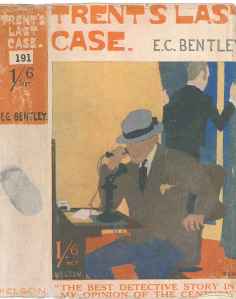
The Setup
The plot at the beginning of the book strongly reminded me of Philip MacDonald’s The Rasp (1924), whereby a newspaper is early on informed of a murder and sends down an ad-hoc reporter to do some amateur sleuthing. There is even the overly efficient secretary who supports the controlling figure at the newspaper. I was also strongly reminded of Robin Forsythe’s work and I do wonder whether the similarities were deliberate on Forsythe’s part as in his detective stories the amateur sleuth (also an artist) often gets backing from a newspaper to nose around. Trent like Anthony Vereker (Forsythe’s sleuth) also has a friendly but competitive relationship with the Scotland Yard inspector solving the case: ‘I suppose we play the game as before.’ Both Vereker and Trent also make allusions to Roman figures.
The Amateur Sleuth
I think this book is also meant to be canonical because of the way Bentley ‘de-herois[es] the detective’ (Stephen Knight, 2003) and Bentley in his autobiography says that he wanted to create a sleuth who was ‘recognisable as a human being’ – e.g. fallible. And to be fair to Bentley he does set his sleuth up for a fall by making him more impressive at the beginning, as he is famed for solving cases and he says heroically that:
‘I should prefer to put it that I have come down in the character of avenger of blood, to hunt down the guilty, and vindicate the honour of society.’
He is also said to have ‘cool judgement’. Of course this all gets turned upside down as the book progresses and he finds he is not so good at this detecting lark after all. What undermines Bentley’s desire for verisimilitude is the way his hero becomes a love struck ninny, as rather than becoming a more fully fleshed and less predictable character, he ends up running along the predictable lines of the archetypal lover. I didn’t therefore appreciate the love angle of this story and quite surprised that Dorothy L Sayers did, as in her introduction to The Omnibus of Crime (1929) she says Bentley ‘dealt finely with the still harder problem of the detective in love… [and that] the love story is handled artistically and with persuasive emotion.’ I can accept that the love element is plausible in the plot but I can’t say it was that interesting to read, particularly in the second half of the novel.
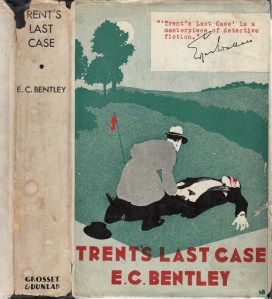
The Woman
Our first information on Mabel is second hand, coming from her uncle and from Trent and I found their impressions of her intriguing, though not making me keen to make her acquaintance. Her uncle says:
‘She has plenty of brains; she is full of character; her mind and her tastes are cultivated; but it is all mixed up with ideals of refinement and reservation and womanly mystery. I fear she is not a child of the age.’
Trent then says on first seeing her that:
‘…with the suggestion of French taste in her clothes, she made a very modern figure seated there, until one looked at her face and saw the glow and triumph of all vigorous beings that ever faced sun and wind and sea together in the prime of the year.’
There is a timeless quality they see in her and also a duality, which I thought very interesting but this avenue is not really explored later in the novel when she is more involved. There is a moment where she becomes more interesting when she passionately defends her preference for a less moneyed life, (though it is confusing why she went for such a rich husband in the first place). But then the love story subplot takes over and this moment is lost and she becomes another sickening heroine.
The Ending
I think if I had been around at the time of publication the ending would have had a greater effect on me and I would have found it much more surprising. But because I have read so many golden age detective novels, the initial solution although clever (tying up all the evidence and clues) did not have much of a wow factor for me. Moreover, the chapter which follows it is rather long and tiresome, with Trent going into love sick swain overdrive, that once the final twist is revealed, it is kind of half expected and therefore doesn’t surprise as much as it should.
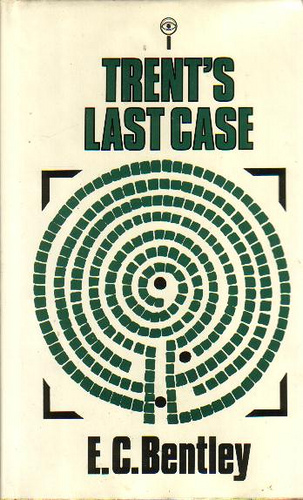
In conclusion….
I can see how Bentley contributed to the features and tropes of early golden age detective fiction and he does have a rich narrative style, making his story arguably a bridge between Victorian mystery fiction and the golden age variety which follows. Moreover, in the beginning his characterisation skills are very strong, doing insightful pen portraits of characters (perhaps another Dickensian touch?). But although this novel can be considered a crucial literary stepping stone, the actual reading experience is found wanting for the modern reader, well this one at any rate! One of the reasons why is that the love subplot undermined the second half of the book, hampering the plot’s pace and it made Trent a less interesting and engaging character, in comparison to how he acts in the first half of the book. I also think as a modern reader that the ending lacked something for me, as my previous golden age genre reading left the plot more familiar than it would have been to a contemporary reader. Consequently when it was published I can see how it could impress readers, but retrospectively I think it loses a number of its strengths for the modern reader, who have seen the template Bentley propagates used in more interesting and successful ways.
Ratings: 3.5/5
That’s it, Kate, kick a classic when it’s down! 🙂
Just kidding. Sometimes a standard of the genre is just boring. I have tried six times to read the play version of Milne’s The Red House Mystery – the PLAY VERSION, mind you. After a while, I just start to blink, put down the book, and wait a year to try again. I’m nearly due . . .
LikeLiked by 1 person
Well, there are many similarities between Trent’s Last Case and The Red House Mystery! I have listed these in the post on The Red House Mystery at Past Offences.
LikeLiked by 1 person
It has been ages since I have read The Red House Mystery, but yes now you mention it, I can see some of the similarities, though I imagine your list on Past Offences is much more extensive. The question is though, did you actually enjoy reading Trent’s Last Case?
LikeLike
Yes, I enjoyed both Trent’s Last Case and The Red House Mystery.
My review of Red House Mystery is at Goodreads.
https://www.goodreads.com/review/show/1432383017
LikeLike
I never knew there was a play version of The Red House Mystery, though from what you say I don’t think I have been missing out much. Have you read Trent’s Last Case then?
LikeLike
Personally I found Trent irritating for almost the entire book.
LikeLiked by 1 person
Well he wasn’t too bad at the beginning but once he sets eyes on the girl it tends to go downhill.
LikeLike
I have this sitting on my shelf, and will probably bump it down on my TBR pile… Thanks for the review! 🙂
LikeLiked by 1 person
[…] my review of E. C. Bentley’s Last Case (1913) on Monday I mentioned a quote from Agatha Christie where she declares her enthusiasm for the […]
LikeLike
[…] year that some “classics” of crime fiction really aren’t that good *cough* E C Bentley’s Trent’s Last Case (1913) *cough*, though some certainly do deserve their classic status, such as Anna K. Green’s […]
LikeLike
[…] date of 1914, my mind immediately jumped back a year to 1913, the year in which E C Bentley’s Trent’s Last Case was published. I don’t know whether Doyle was aware of this novel but it is interesting to […]
LikeLike
[…] to Ellington’s wife, to acting about as sensibly as a HIBK heroine. Equally Revell is a bit of Philip Trent (E. C. Bentley’s fictional amateur sleuth) and it is easy to tell when he starts veering off on […]
LikeLike
[…] an exception to the rule that ‘less love in a detective-story, the better.’ E. C. Bentley’s Trent’s Last Case (1913) is another such exception given by Sayers, as again she argues that the detective in love is […]
LikeLike
[…] to be a continuation of the infallible sleuth mould of detective fiction, echoing E. C. Bentley’s Trent’s Last Case (1913) and Josephine Tey’s Miss Pym Disposes (1946). However it seems that when things do go pear […]
LikeLike
[…] is a short story featuring Bentley’s famous sleuth Philip Trent and unlike in Trent’s Last Case (1913), Trent is no fool and soon gets to the bottom of a forgery scam. […]
LikeLike
[…] definitely overshadowed by his father, E. C. Bentley, who is more famously known for having written Trent’s Last Case (1913), a book which once again shows me running against the tide of popular opinion, finding that […]
LikeLike
[…] Last Case has been reviewed, among others, at the crime segments, Mystery*File, crossexaminingcrime, A Penguin a Week, and Past […]
LikeLike
[…] Judgments – Nick Fuller @ The Grandest Game in the World, Kate @ Cross Examining Crime, Rich Westwood @ Past […]
LikeLike
[…] first sleuth to fall in love with a woman who looks very guilty, Philip Trent in E. C. Bentley’s Trent’s Last Case (1913) famously does so, as does Dorothy L. Sayer’s Lord Peter Wimsey in Strong Poison (1930). I […]
LikeLike
[…] 3. E.C. Bentley: Trent’s Last Case (April 13). Michael Gwynn as Philip […]
LikeLike
[…] Judgments – Nick Fuller @ The Grandest Game in the World, Kate @ Cross Examining Crime, Rich Westwood @ Past […]
LikeLike
[…] against the” Holmes formula”) only occurred post WW1, is also problematic. E. C. Bentley’s Trent’s Last Case (1913) was written as a sendup of the genre (despite this intention misfiring), and Susan Glaspell […]
LikeLike
I completely concur with your review. I was likely hampered by all the glowing accolades I read before getting this book because I expected to be wowed by it….and then I wasn’t.
LikeLiked by 1 person
Yes this read was certainly hard going. Can’t say I tried any of his later efforts.
LikeLike
[…] crossexaminingcrimeMrs K InvestigatesThe Grandest Game in the World […]
LikeLike
[…] Trent’s Last Case (1913) by E. C. Bentley, The Valley of Fear (1914) by Arthur Conan Doyle, The Verdict of You All […]
LikeLike